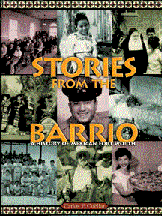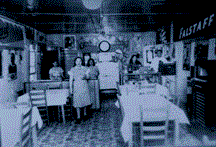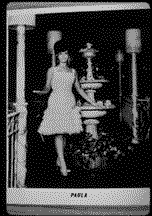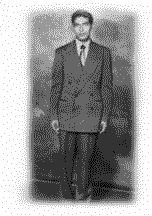|
Stories
from the barrio
Carlos
E. Cuellar's new book tells the stories of the people, places and events
in the history of Fort Worth's Mexican community.

 When
Carlos E. Cuellar '98 (PhD) set out to document the rich history of Mexican
culture in Fort Worth, he found himself in previously unexplored territory.
He discovered a lack of historical documentation of the rise of the fastest-growing
ethnic minority in the city. His book Stories from the Barrio: A History
of Mexican Fort Worth (TCU Press), weaves the threads of many family
stories into one colorful historical cloth. When
Carlos E. Cuellar '98 (PhD) set out to document the rich history of Mexican
culture in Fort Worth, he found himself in previously unexplored territory.
He discovered a lack of historical documentation of the rise of the fastest-growing
ethnic minority in the city. His book Stories from the Barrio: A History
of Mexican Fort Worth (TCU Press), weaves the threads of many family
stories into one colorful historical cloth.
Stories from
the Barrio chronicles the events of Fort Worth's Mexican community from
approximately 1872 to the present.
From Stories
from the Barrio, reprinted with permission:
 Joe
T. Garcia's Mexican Restaurant On July 4, 1935, Joe T. Garcia, his wife
Mama Sus, and their five children, Josephine, Ralph, Pauline, Mary, and
Hope, opened the family restaurant for business under the name "Joe
T. Garcia's." The building sagged so badly it had been condemned,
but the family repaired it, cleaned it up, and gave it a new coat of paint.
They lived in the back and operated the restaurant in the front of their
home. The restaurant consisted of a kitchen and a large room with eight
tables -- two tables for six and six tables for four persons. Both kitchen
and dining room were kept clean and spotless under Mama Sus' close supervision.
Joe T. and his daughters all pitched in to help Mama Sus prepare and serve
the hot dishes, such as carne de chile adobada, enchiladas, tacos, and
tamales de puerco y de dulce. These dishes are traditional Michoacan-style
from Mama Sus' native state. Joe
T. Garcia's Mexican Restaurant On July 4, 1935, Joe T. Garcia, his wife
Mama Sus, and their five children, Josephine, Ralph, Pauline, Mary, and
Hope, opened the family restaurant for business under the name "Joe
T. Garcia's." The building sagged so badly it had been condemned,
but the family repaired it, cleaned it up, and gave it a new coat of paint.
They lived in the back and operated the restaurant in the front of their
home. The restaurant consisted of a kitchen and a large room with eight
tables -- two tables for six and six tables for four persons. Both kitchen
and dining room were kept clean and spotless under Mama Sus' close supervision.
Joe T. and his daughters all pitched in to help Mama Sus prepare and serve
the hot dishes, such as carne de chile adobada, enchiladas, tacos, and
tamales de puerco y de dulce. These dishes are traditional Michoacan-style
from Mama Sus' native state.
Joe T. Garcia
even experimented with Texas chili and southern-style barbeque recipes
obtained from his African-American friend, Stanley Woodard. Stanley's
brother, an excellent chef, owned Jack's Barbeque on Angle Street. Joe
T. added his own special Mexican spices to the recipe and served barbequed
brisket, ribs, chicken, and turkey. Every Thanksgiving, Joe T. prepared
at least fifty turkeys for the Fort Worth Boat Club. He supervised the
slow cooking in a huge, specially built grill, a process that took from
8 p.m. until 8 a.m.
Garcia could
very well have been the first Mexicano who actively courted Anglo business.
To promote his restaurant, Joe T. asked daughter Mary to take sample dishes
to the downtown offices of lawyers, judges, and bankers. Along with the
Mexican food, Mary gave each prospective customer a complimentary flower,
usually a cape jasmine. Joe T. also prepared special banquets and invited
the public to sample his dishes, in part to demonstrate his gratitude
for their continuing patronage. All these efforts, especially word-of-mouth
recommendations, paid off and helped elevate Joe T. Garcia's to the status
of a premier Fort Worth institution and landmark.
The Original
Mexican Eats Cafe
The oldest
Hispanic-owned restaurant still in operation, The Original Mexican Eats
Cafe, opened for business in 1926 at 4713 Camp Bowie Boulevard. Begun
by Geronimo and Lola (San Miguel) Pineda, the business was unique in that
it was not located within any of the Hispanic enclaves within the city.
In spite
of the Great Depression, the Pinedas soon developed a thriving business
and drew a large Anglo clientele that included the cream of Fort Worth
society -- the Leonards, the Moncriefs, and the Carters. Franklin Delano
Roosevelt's son, Elliott, regularly dined at the Original during the late
1930s. Elliott lived in Benbrook with his new bride, Fort Worth socialite
Ruth Googins, and managed his radio and ranching interests in the area.
Tejano
music star Paula
 Tejano
recording artist "Paula" was born Paulina (later Pauline) Willis
on March 17, 1946, at Marlin, Texas, to Ernest and Eulalia Arevalo Willis.
Pauline's popular music career began in 1964 when her cousin, Fay Gomez
(Barrera), introduced her to the leader of a new musical group called
Little Joe and the Latinaires, playing at the Guys and Dolls Ballroom
in South Fort Worth. The huge and wildly popular dance hall had seen the
likes of Harry James, Alfonso Ramos, and other famous bands. At first
Pauline hesitated because good Baptists are not supposed to go to dance
halls, but Faye insisted. When Little Joe first found out that she could
sing, he said, "We've been looking for a female vocalist." "Sure,
I'd love to sing," replied Pauline, thinking that it was just polite
conversation. After all, Little Joe had never heard Pauline sing, and
she had never heard of his band. "We're going to be recording in
Dallas. Can you come?" Tejano
recording artist "Paula" was born Paulina (later Pauline) Willis
on March 17, 1946, at Marlin, Texas, to Ernest and Eulalia Arevalo Willis.
Pauline's popular music career began in 1964 when her cousin, Fay Gomez
(Barrera), introduced her to the leader of a new musical group called
Little Joe and the Latinaires, playing at the Guys and Dolls Ballroom
in South Fort Worth. The huge and wildly popular dance hall had seen the
likes of Harry James, Alfonso Ramos, and other famous bands. At first
Pauline hesitated because good Baptists are not supposed to go to dance
halls, but Faye insisted. When Little Joe first found out that she could
sing, he said, "We've been looking for a female vocalist." "Sure,
I'd love to sing," replied Pauline, thinking that it was just polite
conversation. After all, Little Joe had never heard Pauline sing, and
she had never heard of his band. "We're going to be recording in
Dallas. Can you come?"
"Sure," Pauline
answered, playing along as if the musician was really serious.
"I'll call
you tomorrow. I'll tell you where we'll be in Dallas."
True to his
word, the next day Little Joe called Pauline at the home of her friend
and cousin, Lucy Pena. She began rehearsing songs, especially rancheras,
with the band.
Pauline chose
the stage name Paula to disguise herself and evade her Baptist family's
disapproval. ... Paula sang with Little Joe and his band from September
1964 to October 1966. It was a modern big-band sound that made Little
Joe popular with Mexicanos all over the state.
Vivian de
la Garza convinced Paula to leave Little Joe's band and let Vivian manage
her career. Acting as Paula's agent, vivian booked tours that too the
young singer all over the American Southwest ... to San Francisco, San Jose,
Los Angeles, San Diego, Las Vegas and Phoenix. She sang with well-known
stars ... and was about to make a six-week tour of major cities in South
America. But Paula's fiance objected to this extended tour. Pauline Willis
married Sam Estrada on January 21, 1967, and began a family; her singing
career came to an end.
Louis
J. Zapata, Fort Worth's first Hispanic city councilman
 Louis
J. Zapata was a particularly bright child ... he skipped a grade every
year for four years ... and in 1951 graduated from Technical High School
after completing his coursework in his junior year. Louis
J. Zapata was a particularly bright child ... he skipped a grade every
year for four years ... and in 1951 graduated from Technical High School
after completing his coursework in his junior year.
From the
late 1950s to the early 1960s Louis took night classes in electrical engineering
at Arlington State College (now University of Texas at Arlington). In
1962 and 1963, he attended TCU, enrolling in fine arts and business courses
... accumulating ninety hours of college credit.
An exultant
Louis Zapata was sworn in on April 19, 1977 -- the first Hispanic city
councilman in the history of Fort Worth. The largest crowd of Hispanics
ever to assemble at city hall included family, friends, and supporters
who were there to witness the historic event.
Louis was
an effective councilman and was re-elected for six more two-year terms.
He holds the record for length of service on Fort Worth's City Council
(1977-1991). In 1991 Carlos Puente defeated the esteemed politician using
the slogan "It's time for a change!"
As if all
these responsibilities were not enough, in 1983 the enterprising Zapata
opened a funeral home in a rented mansion located at 2200 Hemphill. In
1988 he bought the old Robert Hall's Clothing Store at 2301 Ephriham Avenue
and with his daughter, Patricia Ann, continued to operate the funeral
home from that location until he sold the business in 1992.
The Caro
family
During the
1920s and 1930s, Juan Bautista Caro and Modesta Cavazos had six children,
(including Maria de Lourdes). By 1932, Juan Bautista had begun to make
plans to open a restaurant in Rio Grande City ... but on November 30, 1934,
Juan Bautista Caro suddenly passed away.
Left alone
to raise six young children, Modesta Cavazoa did what she could to survive.
She took in people's laundry ... even cleaned rooms in a small tourist court.
In time, the owners of the motel agreed to her proposal to open a restaurant
in the motel office.
Modesta did
so well in her restaurant that in four years she was able to establish
a larger freestanding restaurant. Maria de Lourdes ("Lou") became her
mother's right-hand woman.
After the
war, feeling adventurous, Lou Caro decided to leave home and explore other
career options. She headed for Houston, where she worked for a year in
the perfume department of Foley's department store. One day her roommate
arranged a blind date with John Day Whitten. They married on October 9,
1949.
John and
Lou returned to Rio Grande City to help run Caro's Restaurant. Yet in
spite of the fact that the restaurant was flourishing, Lou wondered if
their future there in Rio Grande City was secure. When they took a much-deserved
break in 1954 to visit her sister in Fort Worth, they liked what they
saw. Lou remembers impulsively blurting out, "John, go look for a place
to open a restaurant. I'm tired of working for nothing at Mother's!"
In May 1954,
they leased a building on Bluebonnet Circle and opened Caro's Restaurant.
Initial menu items included chalupas, arroz con pollo, enchiladas, tamales,
tacos de pollo (chicken tacos), and most importantly, their signature
puffed tostadas and guacamole. The Whittens also rented the house in the
back of the restaurant for their growing family.
Carlos
E. Cuellar, assistant professor of history at Texas A&M International
University in Laredo, is director of the Guerrero Viejo Archives Preservation
Project. Stories from the Barrio is available in bookstores or from TCU
Press at 800-826-8911.
Write
Cuellar at ccuellar@tamiu.edu.
Top
|



